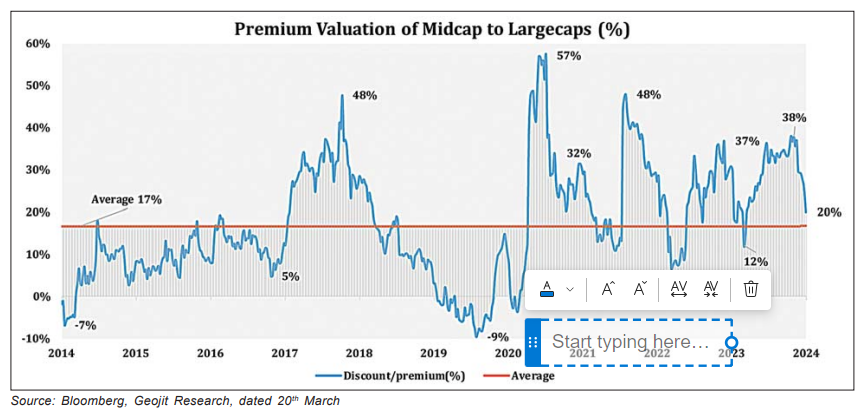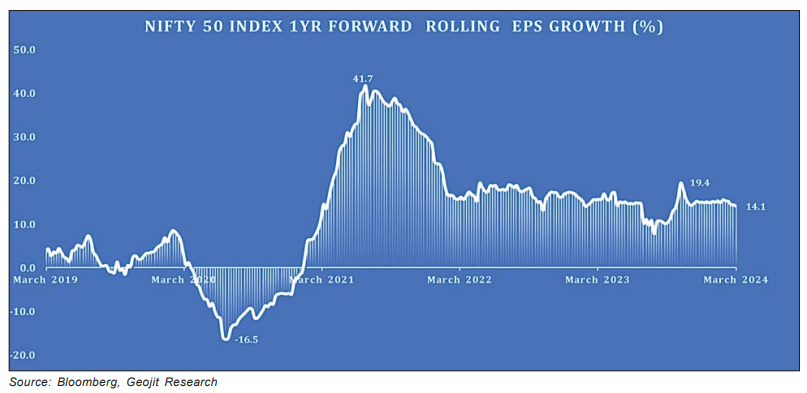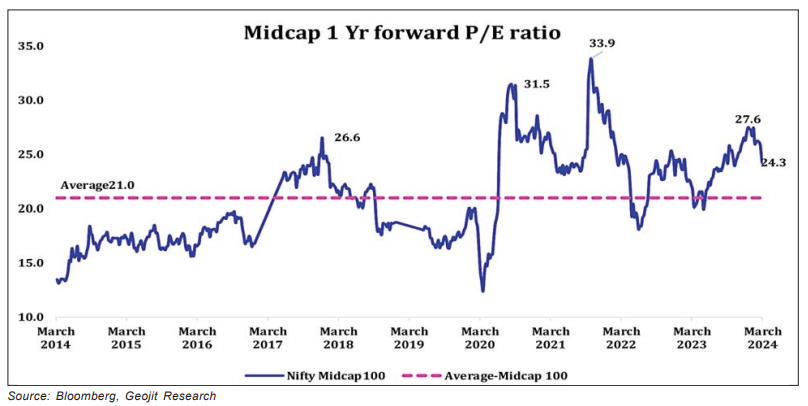Presently, the principal concern in the domestic stock market is about the correction in mid and small caps. The broader market is also facing challenges, and large caps are absorbing the blow with minimum correction. Micro and penny stocks are notably affected by a deeper collapse. This consolidation is warranted by an uneven risk-reward ratio, and we anticipate this trend to endure in the short term. Over the medium to long term, the foundation of the domestic stock market remains robust, yet it faces cyclical hurdles associated with a market at its peak. Key barriers include the allure of alternative assets like debt and gold offering decent returns, heightened election-related expectations and resultant volatility, a diminished risk-to-reward ratio stemming from premium valuations, and the projected deceleration in earnings growth expected in FY25.
Given the widespread recognition of these issues, the current situation appears to offer little more than a temporary pause within the broader long-term momentum. Apart from high valuation, there are no fundamental issues. FIIs and DIIs are continuing their buying spree, while the recent fallout is a short-term restructuring by retail investors, triggered by fiscal year-end tax planning, SEBI’s cautious comments, and cutting-off leverage positions.
Considering the absence of fundamental negatives, we expect the consolidation to have a shadowy effect. More than the price fall, time correction could be the lingering factor, and small and micro stocks will have to bear most of the declines.
The earnings growth of midcaps is forecast to be healthy next year, at 20%. This should depict a stable outlook in FY25. A consolidation should develop a good financial breakout to invest in the medium-term. Stock picks and value buying should be the key parameters for investing in the growing mid-caps.

Lack of fundamental issues other than premiumisation
The central issue driving the sell-off of midcaps is largely attributed to inflated valuations. Other fundamental concerns are not readily apparent, especially considering the ongoing improvement observed in the real economy on a QoQ basis. RBI has updated the GDP growth forecasts for FY24 and FY25 to 7.3% and 7.0%, respectively, from the sustainable average of 6% to 6.5% depicted one year ago.
The top price growth of the midcap index was 60% in FY24, which traces earnings growth by 2x times, 30% earnings growth, leading to premium valuation. In February 2024, the premiumization of midcaps over large caps reached a record level of 40%. Currently, it is consolidated at 20% above the long-term average of 17%.
A slowdown in earnings growth
This narrowing of premiumisation is deemed appropriate as future earnings growth is expected to ease in FY25. The key factors for moderation in profitability are the tempering of pent-up demand, increase in input costs, and a slowdown in the rural market.
Though generally varied, qualitative and quantitative considerations contribute to the emergence of stocks. The crux of a stock market rally hinges on two fundamental factors: earnings growth and the capital flows. Corporate earnings growth has been upgraded after the Q3 results. However, for FY25, this growth trajectory is expected to taper off compared to the surge which was driven by pent-up demand from FY21 to FY24. For instance, the midcap150 index’s EPS (Earnings Per Share) CAGR was 35%. The EPS growth in FY24 is estimated at 30% YoY and is forecast to slow to 20% in FY25.

Capital inflows are stable
The role of capital inflow is significant for midcaps in FY24, with substantial inflows from retail investors. Retail investors have been pivotal players in the Indian stock market, demonstrating considerable buying activity since April 2023 across both direct investments and through mutual funds. NSE data shows that in the last five years between 2019 and 2023, over 12 crore new investors were registered. In February 2024 alone, more than 49 lakh investors were added. As per BSE, as of 20th March 2024, the number of registered investors stood at nearly 16.6 crore. Retail investors exhibit a strong presence in mid and small caps as well as in the futures and options segment.
If we look at March equity net inflow data, FIIs and DIIs were strong net buyers. MFs have bought better MoM Rs 23,864 crore and FIIs Rs 38,145 crore till 18th of March. Therefore, it appears that aside from retail investors, no other parties are to be blamed for the correction observed in midcaps during March 2024.
Cautious remarks from SEBI
The outflow is also the effect of annual tax planning and shuffling to low-risk assets like large caps and gold. Moreover, SEBI’s warning regarding the irrational exuberance in mid and small caps, coupled with the directive for MFs to conduct stress tests on their schemes, has influenced sentiment among retail investors and brokerages. Despite MFs successfully undergoing stress tests without further negative impact on market sentiment, they remain robust buyers in the broader market. However, several MFs have slowed down, taking in new inflows in mid and small caps only through SIPs. Brokers have also advised clients to partially liquidate their leveraged positions due to increased volatility during the month, prompting a sell-off by retail investors. Large caps are down by 1.0%, mid caps by 5% and small caps by 9% in the last month, based on 20th March 2024 closing data.

The broad position of the market is safe
We don’t expect a further deep price cut, as corporate earnings are forecast to be healthy at 14% for large caps and 20% for midcaps in FY25. Moreover, the upgrade of India’s GDP growth to 7% in FY25, based on better-than-expected quarterly GDP announcements, hints at the upside prospect of business growth.
Midcaps are currently experiencing a transient period of flux, driven by excessive enthusiasm that has propelled prices well beyond earnings growth. We presume that the valuation will consolidate in the medium-term. However, we assume that midcaps will be able to hold the long-term premium to large caps. The long-term average premium is 17%; hence, the medium-term downside should be protected, which should be a blend of time and price corrections.
We anticipate a resurgence in retail inflows during Q1FY25 after the restructuring of the portfolio, the Lok Sabha election, and the final Budget. However, we expect moderation in valuation from prolonged high to low twenties due to the combination effect of a slower global economy, non-equity opportunities and moderation in profitability. The current one-year forward P/E of midcaps is above the long-term average at 25x, and that of the main index is at 20x. We do expect a positive and balanced-out return from midcaps in FY25 compared to the bumper performance of FY21 to FY24. Moving forward, stock selection and value buying will be critical factors in investing in high-growth midcaps.






